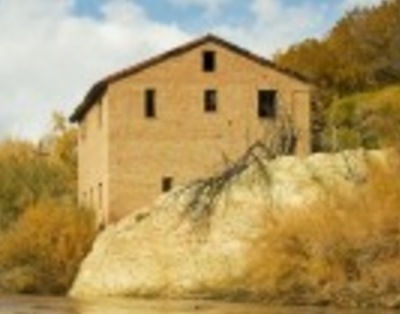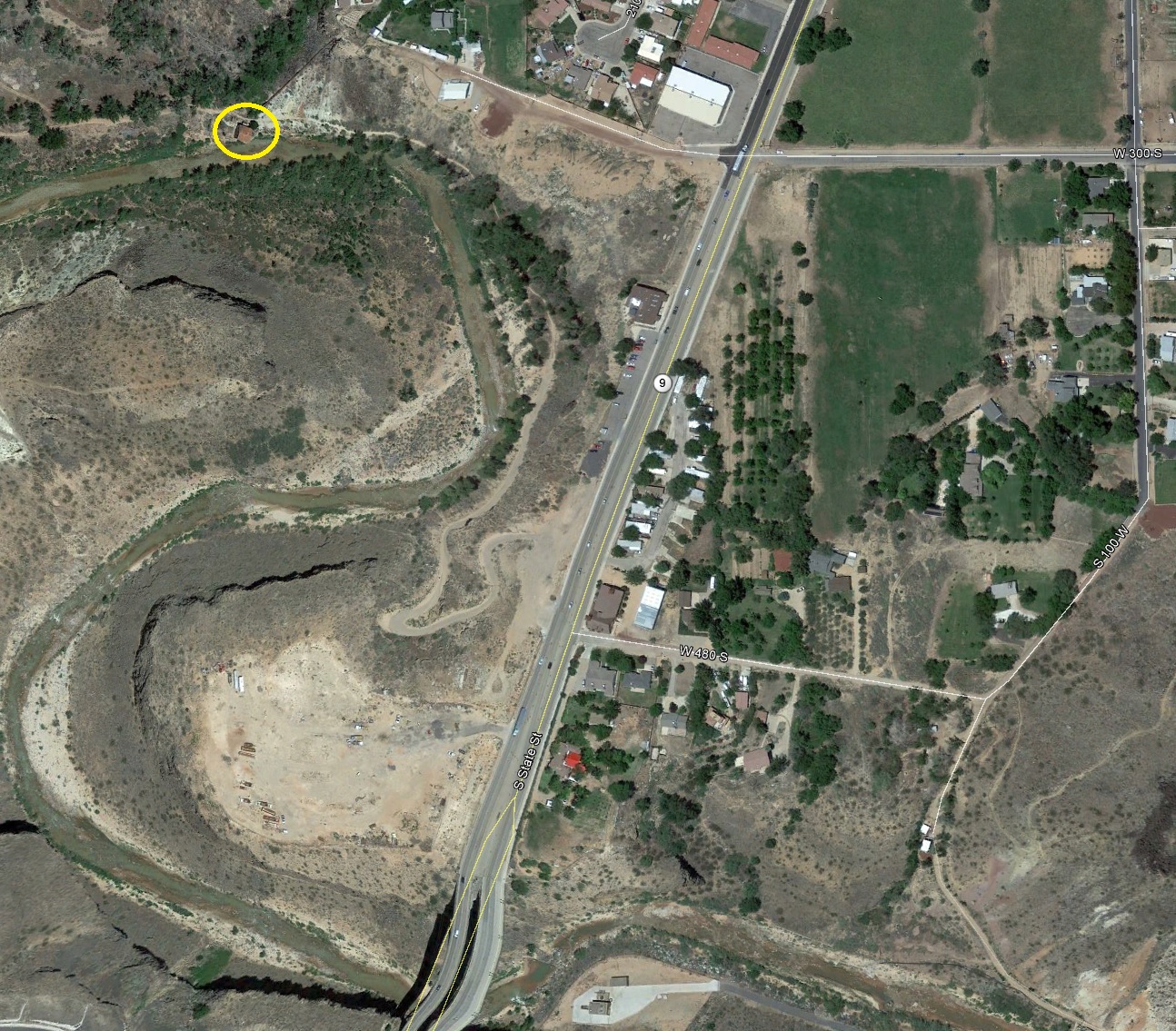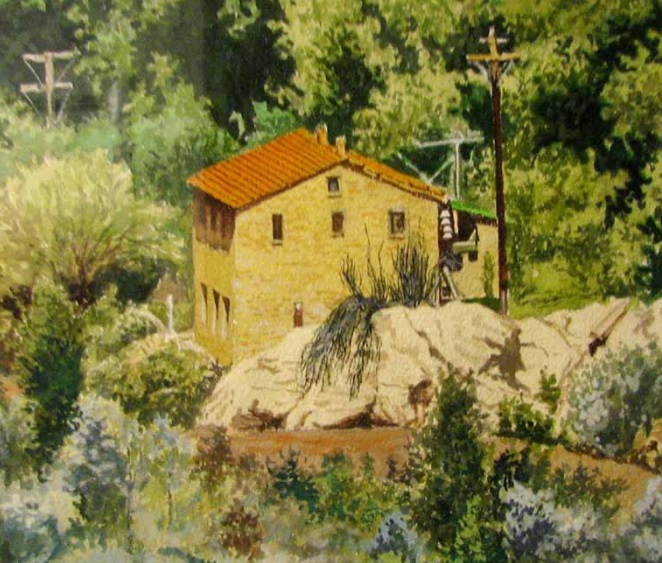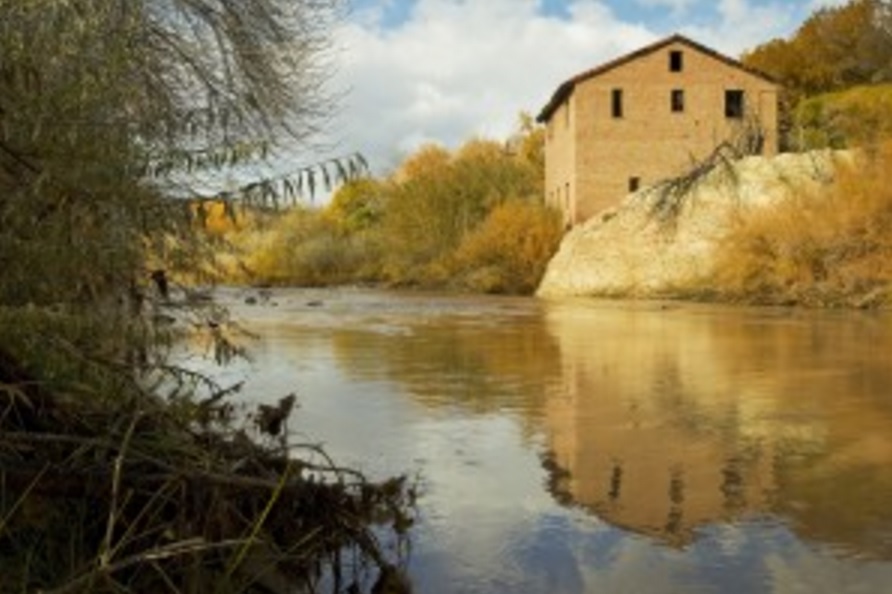
WASHINGTON COUNTY HISTORICAL SOCIETY (Washington County, Utah)
HURRICANE-LAVERKIN HYDROELECTRIC POWER PLANT
(aka POWER PLANT #4)
Hurricane/LaVerkin, Utah
LOCATION

For a larger view, click here. For a closer in view, click here.
37° 11' 45.2" North Latitude, 113° 16' 46.1" West Longitude
37.1959° North Latitude, 113.2795° West Longitude
3,022 feet (921 meters) MSL
DESCRIPTION
A pipe, initially wood and later metal, 42 inches in diameter carried water from the LaVerkin Irrigation Canal down to the hydroelectric plant.Electricity was generated when water under high pressure was fed over a Pelton wheel (patented in 1889 by American engineer, Lester Allen Pelton) which was connected to a generator. A Pelton wheel resembles an old fashioned water wheel rather than a turbine. If no water was running over the wheel, but electricity was coming in from other sources, the generator would act as an electric motor. The Pelton wheel was designed to run within a specific RPM range; if allowed to run too fast, it could literally throw itself to pieces. When the generator was producing electricity, the resultant friction kept the Pelton wheel at a safe speed. If, however, the generator were turned off, the Pelton wheel would soon reach catastrophic speeds. To prevent this from happening, a shunt was designed to automatically drop down when the power went off and divert the water out into the river channel. Damage to the wheel often necessitated a welder crawling inside, assuming a most awkward position and making a weld that was precariously close to his body.
There was an apartment on the upper floor where the chief operator of the plant could live.
HISTORY
The Dixie Power Company planned and built this hydroelectric plant in 1928 and 1929. It was the largest of a network of four hydroelectric plants. Water rights were obtained from the LaVerkin Bench Canal Company. Estimated cost of the plant was $90,000. It was rated at 899 kilowatts and was operational by April 12, 1929. Fred Brooks, whose family lived at the plant, was in charge.Changes took place over the years. The original wood pipe was replaced with metal pipe. The power plant machinery was upgraded. And the plant was finally semi-automated so that it became unnecessary for someone to live on the premises.
Winston Stratton, who was a skilled welder, usually got the job of repairing the damage blades of the Pelton wheel.
Kay McMullin was chief operator of the plant from 1958 until it closed in 1983. He ordinarily worked alone, maintaining flow through the canal and through the pipe.
The plant met a sudden end in 1983. McMullin returned from a vacation to find the Pelton wheel and other machinery in shambles. Lightning may have caused a power shut-off and the deflector plate may have failed to fall in place. Or a disgruntled exemployee may have sabotaged it. In any case, the Pelton wheel had spun out of control and came apart. Rebuilding was economically unfeasible. The machinery and pipe were sold as scrap metal.
This property is currently owned by Washington County.
PHOTOS
 Painting by Farrell Collett |
 Photo of the old Hydroelectric Plant on the Virgin River |
WCHS-03977 Photo of the valley upstream of the old Hurricane-LaVerkin Hydroelectric Power Plant
WCHS-03978 Photo of the valley downstream toward the old Hurricane-LaVerkin Hydroelectric Power Plant
WCHS-03979 Photo of the dirt road leading to the old Hurricane-LaVerkin Hydroelectric Power Plant
WCHS-03980 Photo of the dirt road approaching the old Hurricane-LaVerkin Hydroelectric Power Plant
WCHS-03981 Photo of the west face of the old Hurricane-LaVerkin Hydroelectric Power Plant
WCHS-03982 Photo of stairs leading down to the west entrance of the Hurricane-LaVerkin Hydroelectric Power Plant
WCHS-03983 Photo of the west and south sides of the old Hurricane-LaVerkin Hydroelectric Power Plant
WCHS-03984 Photo of the north face of the old Hurricane-LaVerkin Hydroelectric Power Plant
WCHS-03985 Photo of the pipeline leading down to the old Hurricane-LaVerkin Hydroelectric Power Plant
WCHS-03986 Photo of a tower for supporting power lines at the old Hurricane-LaVerkin Hydroelectric Power Plant
WCHS-03987 Photo of a large water pipe coming into the old Hurricane-LaVerkin Hydroelectric Power Plant
WCHS-03988 Photo of a large water pipe coming into the old Hurricane-LaVerkin Hydroelectric Power Plant
WCHS-03989 Photo of some machinery in the old Hurricane-LaVerkin Hydroelectric Power Plant
WCHS-03990 Photo of a part of the generator at the old Hurricane-LaVerkin Hydroelectric Power Plant
REFERENCES
Hurricane, LaVerkin Hydro-electric PlantPages 12-13 in "Selected Topics Related To Hurricane, Utah"
Written and/or compiled by Victor Hall, 2003.
La Verkin Hydro Electric
History Outline for WCHS Field Trip, November 21, 2015
Compiled by Richard Kohler.
Confluence Nature Park: Activity in the 1900s: Electrical Power Generated from the Virgin River
http://www.redcliffsdesertreserve.com/wp-content/uploads/2012/08/Activity-in-the-1900s.pdf
by The Red Cliffs Desert Reserve